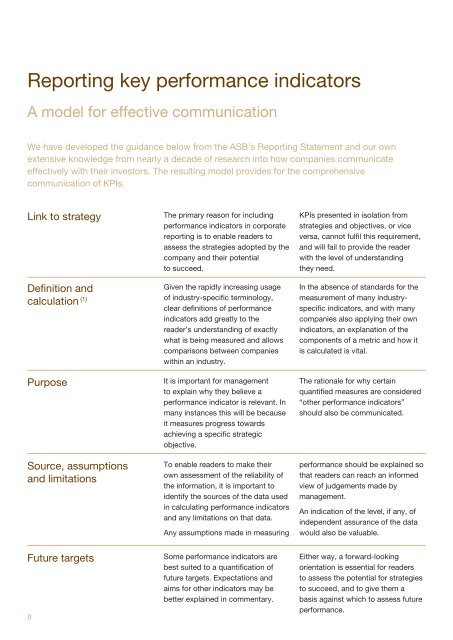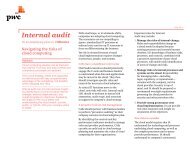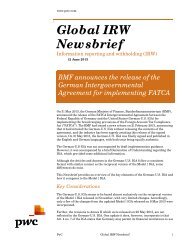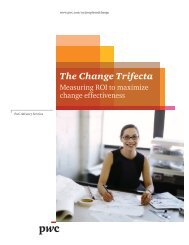Guide to key performance indicators - PwC
Guide to key performance indicators - PwC
Guide to key performance indicators - PwC
You also want an ePaper? Increase the reach of your titles
YUMPU automatically turns print PDFs into web optimized ePapers that Google loves.
Reporting <strong>key</strong> <strong>performance</strong> indica<strong>to</strong>rs<br />
A model for effective communication<br />
We have developed the guidance below from the ASB’s Reporting Statement and our own<br />
extensive knowledge from nearly a decade of research in<strong>to</strong> how companies communicate<br />
effectively with their inves<strong>to</strong>rs. The resulting model provides for the comprehensive<br />
communication of KPIs.<br />
Link <strong>to</strong> strategy<br />
Defi nition and<br />
calculation (1)<br />
Purpose<br />
Source, assumptions<br />
and limitations<br />
Future targets<br />
8<br />
The primary reason for including<br />
<strong>performance</strong> indica<strong>to</strong>rs in corporate<br />
reporting is <strong>to</strong> enable readers <strong>to</strong><br />
assess the strategies adopted by the<br />
company and their potential<br />
<strong>to</strong> succeed.<br />
Given the rapidly increasing usage<br />
of industry-specifi c terminology,<br />
clear defi nitions of <strong>performance</strong><br />
indica<strong>to</strong>rs add greatly <strong>to</strong> the<br />
reader’s understanding of exactly<br />
what is being measured and allows<br />
comparisons between companies<br />
within an industry.<br />
It is important for management<br />
<strong>to</strong> explain why they believe a<br />
<strong>performance</strong> indica<strong>to</strong>r is relevant. In<br />
many instances this will be because<br />
it measures progress <strong>to</strong>wards<br />
achieving a specifi c strategic<br />
objective.<br />
To enable readers <strong>to</strong> make their<br />
own assessment of the reliability of<br />
the information, it is important <strong>to</strong><br />
identify the sources of the data used<br />
in calculating <strong>performance</strong> indica<strong>to</strong>rs<br />
and any limitations on that data.<br />
Any assumptions made in measuring<br />
Some <strong>performance</strong> indica<strong>to</strong>rs are<br />
best suited <strong>to</strong> a quantifi cation of<br />
future targets. Expectations and<br />
aims for other indica<strong>to</strong>rs may be<br />
better explained in commentary.<br />
KPIs presented in isolation from<br />
strategies and objectives, or vice<br />
versa, cannot fulfi l this requirement,<br />
and will fail <strong>to</strong> provide the reader<br />
with the level of understanding<br />
they need.<br />
In the absence of standards for the<br />
measurement of many industryspecifi<br />
c indica<strong>to</strong>rs, and with many<br />
companies also applying their own<br />
indica<strong>to</strong>rs, an explanation of the<br />
components of a metric and how it<br />
is calculated is vital.<br />
The rationale for why certain<br />
quantifi ed measures are considered<br />
“other <strong>performance</strong> indica<strong>to</strong>rs”<br />
should also be communicated.<br />
<strong>performance</strong> should be explained so<br />
that readers can reach an informed<br />
view of judgements made by<br />
management.<br />
An indication of the level, if any, of<br />
independent assurance of the data<br />
would also be valuable.<br />
Either way, a forward-looking<br />
orientation is essential for readers<br />
<strong>to</strong> assess the potential for strategies<br />
<strong>to</strong> succeed, and <strong>to</strong> give them a<br />
basis against which <strong>to</strong> assess future<br />
<strong>performance</strong>.

















